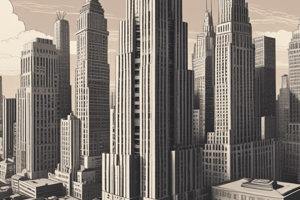Podcast
Questions and Answers
What distinguishes modern skyscrapers from earlier tall buildings?
What distinguishes modern skyscrapers from earlier tall buildings?
- Use of primarily wooden structural components.
- Exclusively residential functions.
- Height of at least 100 meters (330 feet). (correct)
- Absence of elevator systems.
Curtain walls are load-bearing components in skyscraper construction.
Curtain walls are load-bearing components in skyscraper construction.
False (B)
What innovation by Henry Bessemer significantly contributed to skyscraper construction?
What innovation by Henry Bessemer significantly contributed to skyscraper construction?
mass-produced steel
Louis Sullivan, known as the 'Father of Skyscrapers,' designed the ______ Building in St. Louis.
Louis Sullivan, known as the 'Father of Skyscrapers,' designed the ______ Building in St. Louis.
Match the following global cities with their skyscraper-related significance:
Match the following global cities with their skyscraper-related significance:
What was a primary factor limiting the early adoption of skyscrapers in Europe?
What was a primary factor limiting the early adoption of skyscrapers in Europe?
Tuned Mass Dampers (TMDs) are used in skyscrapers to reduce wind and seismic forces.
Tuned Mass Dampers (TMDs) are used in skyscrapers to reduce wind and seismic forces.
What design aspect of skyscrapers helps reduce wind loads by tapering the structure or using setbacks?
What design aspect of skyscrapers helps reduce wind loads by tapering the structure or using setbacks?
The concept of intelligent buildings emerged in the ______ in the United States.
The concept of intelligent buildings emerged in the ______ in the United States.
Match the following green building rating systems with their origin:
Match the following green building rating systems with their origin:
What is the main role of Building Management Systems (BMS) in intelligent buildings?
What is the main role of Building Management Systems (BMS) in intelligent buildings?
Smart LED lighting systems adjust brightness based on occupancy and daylight.
Smart LED lighting systems adjust brightness based on occupancy and daylight.
What is the primary focus of resilient building design in the context of intelligent buildings?
What is the primary focus of resilient building design in the context of intelligent buildings?
The early form of high-rise buildings used ______ walls for support, which limited their height.
The early form of high-rise buildings used ______ walls for support, which limited their height.
Match the following generations of high-rise buildings with their key characteristics:
Match the following generations of high-rise buildings with their key characteristics:
Which innovation enabled the construction of skyscrapers by Elisha Otis?
Which innovation enabled the construction of skyscrapers by Elisha Otis?
Minimalist design is a key development of the first generation of high-rise buildings.
Minimalist design is a key development of the first generation of high-rise buildings.
What structural innovation, featuring steel frames, replaced thick masonry walls in steel-framed buildings?
What structural innovation, featuring steel frames, replaced thick masonry walls in steel-framed buildings?
A ______ is a structural system used in buildings to resist lateral loads, such as wind and earthquakes.
A ______ is a structural system used in buildings to resist lateral loads, such as wind and earthquakes.
Match the following types of bracing with their description:
Match the following types of bracing with their description:
Which statement accurately contrasts concentric and eccentric bracing systems?
Which statement accurately contrasts concentric and eccentric bracing systems?
Braced-frame systems require minimal maintenance and no inspections.
Braced-frame systems require minimal maintenance and no inspections.
What type of frame resists both vertical and lateral loads through the bending of beams and columns?
What type of frame resists both vertical and lateral loads through the bending of beams and columns?
Adding ______ during construction is facilitated by prefabricated rigid frame parts.
Adding ______ during construction is facilitated by prefabricated rigid frame parts.
Match descriptions to the appropriate frame structure
Match descriptions to the appropriate frame structure
What is a key characteristic of shear walls in structural systems?
What is a key characteristic of shear walls in structural systems?
Ductility is the ability of a structure to resist deformation under stress.
Ductility is the ability of a structure to resist deformation under stress.
In a dual system, which element primarily handles horizontal loads?
In a dual system, which element primarily handles horizontal loads?
For seismic performance, ______-resisting frames should provide energy dissipation through ductile behavior.
For seismic performance, ______-resisting frames should provide energy dissipation through ductile behavior.
Match the following structural systems with their defining features:
Match the following structural systems with their defining features:
Flashcards
Skyscraper Definition
Skyscraper Definition
A continuously habitable building with multiple floors for residential, commercial, or mixed-use.
First Skyscraper
First Skyscraper
Home Insurance Building in Chicago (1885), designed by William Le Baron Jenney, using a structural steel frame.
Skyscraper Key Features
Skyscraper Key Features
Steel frameworks provide stability, replacing thick masonry walls. Curtain walls allow larger windows. Elevators enable high-rise accessibility.
Mass-Produced Steel
Mass-Produced Steel
Signup and view all the flashcards
Safe Passenger Elevators
Safe Passenger Elevators
Signup and view all the flashcards
Optimized Shapes
Optimized Shapes
Signup and view all the flashcards
Structural Damping
Structural Damping
Signup and view all the flashcards
Urban Density
Urban Density
Signup and view all the flashcards
Structural Stability
Structural Stability
Signup and view all the flashcards
Intelligent Building
Intelligent Building
Signup and view all the flashcards
Intelligent Buildings Context
Intelligent Buildings Context
Signup and view all the flashcards
Building Management Systems
Building Management Systems
Signup and view all the flashcards
Energy-Efficient Designs
Energy-Efficient Designs
Signup and view all the flashcards
Green Building Rating Systems
Green Building Rating Systems
Signup and view all the flashcards
Building Automation Systems
Building Automation Systems
Signup and view all the flashcards
Tubular Designs
Tubular Designs
Signup and view all the flashcards
Advanced Energy Systems
Advanced Energy Systems
Signup and view all the flashcards
Urban Integration
Urban Integration
Signup and view all the flashcards
High-Rise Evolution
High-Rise Evolution
Signup and view all the flashcards
Residential buildings
Residential buildings
Signup and view all the flashcards
Mixed-Use Buildings
Mixed-Use Buildings
Signup and view all the flashcards
Zoning laws
Zoning laws
Signup and view all the flashcards
Art Deco Style
Art Deco Style
Signup and view all the flashcards
Framework Changes
Framework Changes
Signup and view all the flashcards
Key features
Key features
Signup and view all the flashcards
Innovations
Innovations
Signup and view all the flashcards
Braced Frame
Braced Frame
Signup and view all the flashcards
Diagonal Bracing
Diagonal Bracing
Signup and view all the flashcards
Horizontal bracing system
Horizontal bracing system
Signup and view all the flashcards
Advantages Frame
Advantages Frame
Signup and view all the flashcards
Study Notes
- A skyscraper is a tall, continuously habitable building with multiple floors for residential, commercial, or mixed-use purposes
- Modern skyscrapers measure at least 100 meters (330 feet) tall
- Supertall buildings measure 150 meters (490 feet) and above
- Buildings with 10-20 stories were considered skyscrapers in the 1880s
Purpose & Key Features
- Skyscrapers serve commercial, residential, and mixed-use functions
- Key features include steel frameworks, curtain walls, and elevators
Pre-Skyscraper Era & Early Innovations
- Early multi-story structures include Roman apartments (7-8 stories) and Medieval Scottish Tenements (up to 14 stories)
- Limitations included thick masonry walls and lack of water pumps
- Mass-produced steel, invented by Henry Bessemer allowed for lighter, stronger structures
- Safe passenger elevators were invented by Elisha Graves Otis in the 1850s, make upper floors practical for living and business
The First Skyscrapers
- The Home Insurance Building in Chicago (1885) is considered the world's first skyscraper
- It was 10 stories (138 ft) and later expanded to 12 stories, designed by William Le Baron Jenney and the first to use a structural steel frame
- The Wainwright Building in St. Louis (1890) was designed by Louis Sullivan ("Father of Skyscrapers") and introduced vertical bands to emphasize height
Global Expansion of Skyscrapers
- Chicago is the birthplace of skyscrapers and skeleton frame
- New York City pushed height limits
- Early adoption in Europe was limited due to fire safety and aesthetic concerns.
- Early examples: Boerentoren (Antwerp, 1932) and Torre Piacentini (Genoa, 1940)
- Asia & the Middle East saw a rapid skyscraper boom in the late 20th - 21st century
- Examples: Burj Khalifa (Dubai) – World's tallest building, and Shanghai Tower (Shanghai)
Key Technological & Design Innovations
- Steel frames replaced thick masonry walls
- Curtain walls allow for more glass, improving lighting & aesthetics
- Tubular designs improve resistance to wind & seismic forces
Aerodynamics & Wind Resistance
- Optimized shapes such as tapered, setbacks, and curved corners reduce wind loads
- Structural damping uses Tuned Mass Dampers (TMDs) to absorb vibrations
Vertical Transportation
- Elevators are core components of skyscrapers
- Modern advancements include double-deck & high-speed elevators for efficiency
Environmental & Social Impacts
- Green building practices include solar panels and wind turbines
- Water conservation includes rainwater harvesting and graywater recycling
- Energy efficiency is achieved through advanced HVAC systems and efficient lighting
- Increased urban density maximizes land use, reduces urban sprawl
- Cultural significance represents economic power & technological progress
Design Principles for Tall Buildings
- Structural stability is achieved with braced tubes, diagrids, and outrigger systems that resist wind & earthquakes
- Efficient space utilization uses multi-functional spaces (commercial, residential, retail)
Future Trends in Skyscrapers
- Smart technology provides energy management, security, and automation
- Sustainable design uses net-zero energy buildings and carbon-neutral materials
- Vertical urbanism uses Interconnected skyscrapers with skybridges & shared utilities
- Human-centric design uses sky gardens and terraces for community interaction
Intelligent Buildings Definition
- Integrate technology to create a productive, cost-effective, and sustainable environment
- The Intelligent Building Institute says a building that maximizes technical performance, investment savings, and operational cost efficiency
- Focuses on automation, energy efficiency, and occupant comfort
Historical Context
- The intelligent building concept emerged in the 1980s in the United States with the goal of integrating energy efficiency, safety, telecommunications, and automation
Core Elements of an Intelligent Building
- Occupants ensured comfort, security, and productivity that responds to human needs through smart systems
- Structure and systems designed to minimize environmental impact and maximizes functionality and adaptability
- Advanced Technologies use IT and automation to enhance performance and address energy, environmental, and user experience challenges
Key Features of Intelligent Buildings
- Uses Building Management Systems (BMS) to Control lighting, HVAC, security, and energy.
- Sensors & IoT Devices Real-time monitoring for better efficiency
- Energy-Efficient Designs Uses solar panels, wind turbines, and smart energy systems.
Green Building Rating Systems
- Encourage sustainable practices in building design, construction, and operations
Benefits of Green Rating Systems
- Reduces costs and improves energy and water efficiency
- Improves health with better air quality and lighting.
- Supports sustainability while aligning with global environmental goals
Global Green Building Rating Systems
- LEED (Leadership in Energy and Environmental Design) Developed by U.S. Green Building Council and focuses on energy efficiency, water conservation, and indoor quality
- CASBEE (Japan) Evaluates the environmental performance in buildings and urban areas.
- Philippine Green Building Rating System: BERDE (Building for Ecologically Responsive Design Excellence) which is Developed by PHILGBC and Customized for local environmental and legislative requirements
Intelligent Building Technologies
- Building Automation Systems (BAS) monitors and controls building functions (HVAC, lighting, security) to reduce costs
- Improves safety and comfort and supports remote monitoring (loT-based)
Mechanical Systems in Intelligent Buildings
- Smart HVAC Systems Adjusts based on weather and occupancy
- Variable Air Volume (VAV) Systems Optimizes energy consumption
Advanced Energy Systems
- Uses renewable energy (solar, wind, geothermal)
- Demand response systems Helps reduce peak energy use.
- Smart LED Lighting has sensors adjust brightness based on occupancy and daylight
Sustainability in Intelligent Buildings
- Principles of Sustainability: Uses technology to reduce energy waste
- Water Conservation rainwater harvesting and graywater recycling
- Waste Management Minimizing construction & operational waste
Sustainable Intelligent Buildings
- Net Metropolis (Philippines)
- First BERDE-certified building
- Features rainwater harvesting & condensate water collection
- Children's Healthcare of Atlanta Center for Advanced Pediatrics is LEED Gold-certified and Focuses on energy efficiency & health-centered design
Social impact of intelligent buildings
- Enhances occupant well-being and satisfaction while encouraging community interaction, shared spaces & sustainable practices
Economic Advantages of Intelligent Buildings
- Lower costs which reduces energy and maintenance expenses
- Higher property value increases marketability
Future of Intelligent Buildings
- Emerging Trends: AI & Machine Learning Predicts energy needs & maintenance.
- Decentralized buildings generate & store their own power
- Urban buildings are part of smart cities while also being interconnected for optimized urban living.
- Resilience & Adaptability is designed to withstand climate change & future technologies
Evolution of High-Rise Buildings
- High-rise buildings have evolved due to advancements in engineering, materials, and urbanization and are categorized based on architectural and technological innovations
- Types: Office, Hotel, Residential, Mixed-Use
1st Generation (1885-1916): Load-Bearing Structures
- Key Development: Elevator Innovation: Introduced by Elisha Otis in 1854, enabling skyscraper construction and curtain walls
- Notable Architects: Louis Sullivan, Dankmar Adler, Daniel Burnham
- Notable Buildings: Auditorium Building, Wainwright Building, Monadnock Building
- Key Features: Thick and heavy walls built with brick, stone, and cast iron and a firehazard
2nd Generation (1916-1940): Early Steel-Framed Buildings
- Key Developments: Zoning Laws (1916), Art Deco Style structural improvements
- Notable Architects: William Van Alen (Chrysler Building) Key Features, steel-framed structures, masonry enclosures, concrete floors
3rd Generation (1940-1973): Modern Skyscrapers
- Key Developments: Minimalist Approach, Second, Chicago School, structural innovations
- Notable Architects: Mies van der Rohe (and influenced the use of open floor plans and steel framing)
- Notable Buildings: Lake Shore Drive Apartments, Willis Tower Key Features: steel frames, curtain walls, central core, artificial lighting
4th Generation (1973-Present): High-Tech Architecture
- Key Developments: High-Tech Design, Open Spaces and Notable Architects: Norman Foster
- Notable Buildings: HSBC Hong Kong Tower, design: Use of natural ventilation and renewable energy, Key Features: Hybrid structural systems
- Elevator enclosures are designed for fire and smoke protection
5th Generation (1997-Present): Post-9/11 Safety Innovations
- Key Developments: Advanced materials and energy-saving systems
- Earthquake structure resilience
Braced-Frame Structural System
- A braced frame is a structural system used in buildings that face lateral loads, like wind and earthquakes for stability
- Transfers horizontal loads to the foundation
- Can take both axial loading and bending loading
- Can enhance load-bearing capacity and resistance to lateral forces which include resistance to seismic activity by Limits damage during windstorms
- Bracing systems needs routine maintenance to ensures peak functioning but can increase costs
Rigid Frame Structure
- Rigid frame systems are also known as moment frame systems, are utilized in steel and reinforced concrete buildings consisting of beams and columns.
- A rigid frame structure uses connections that do not allow any relative rotation between the ends of the members and fixed connections efficiently handle vertical and horizontal loads.
- Rigid frame structures resist corrosion minimizing upkeep costs and can limit design flexibility
A Wall Frame Structural Systems
- A structural element that resists lateral forces is called a moment frame
- A dual system requires being designed with both shear walls and moment frames
- Rigid connections offer more strength because the structure will be subject to little cracking and deflection
Considerations for Dual Frame System
The Shear wall system Provides most of the lateral stiffness, while the moment frame contributes flexibility and ductility and ensure a balanced ratio
- Shear walls can form a Y-shaped core, enhance the structure due to the seismic and wind resistance that are in place
- Frame should ensure it’s easy to build by considering the sequence of components being implemented
Shear Wall Structural Systems
- Shear wall system resist lateral forces such as wind or earthquakes provides stiffness and strength; helping maintain stability
- Distributing the loads evenly preventing failure: made of steel concrete or reinforced wood
- Common within high seismic regions
Structural System
- Core can be located in various locations, positioned away from the center along edges or corners
- Improves structual functions and the distrubion
- Prevents vertical and lateral loads, as well as providing internal structual and design support
Outrigger system
- Improves strutual sturdiness for high rise buildlings and resists external enviornment
Infilled Frame Structure
- System that consist of a framework of beams and columns and is commonly to support buildings
- Prevents lateral and seismic activity
- Brick or clay can be used to make or support structural systems
Flat Plate and Flat Slab Structural System
- Can be both uniformly enforced
- Has thick parts that are near columns
- Rebar spacing should provide strength
Tubular Structural Systems
- Used in hight rise buildings to resist wind
- Maximizing usability of the space provided , high and high resistance, allows good floor designs, constructed for lateral loads.
- Effective distribution and structural effiency
- Uses a number of steel tubes that extends from the ground up
- A cylinder style structure that behaves as a tube to the floor
Coupled shear wall
- This shear wall system uses two Shear walls together. Shear walls are Short steep linking beams and lateral forces that minimize effects.
Studying That Suits You
Use AI to generate personalized quizzes and flashcards to suit your learning preferences.



